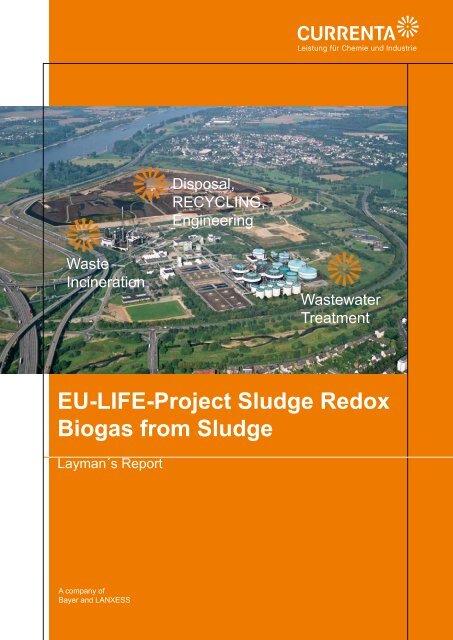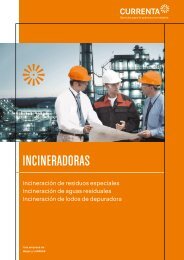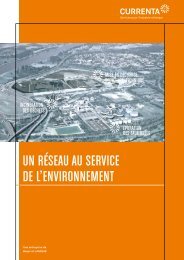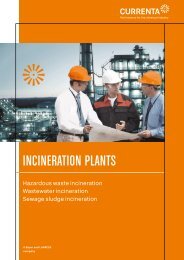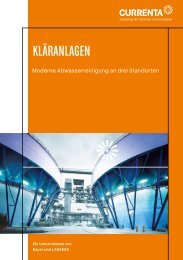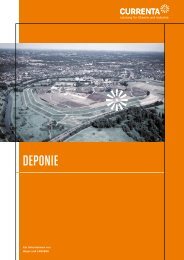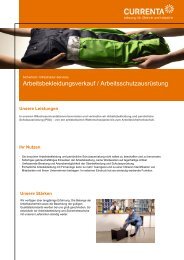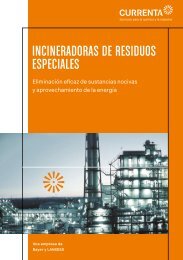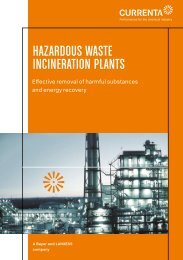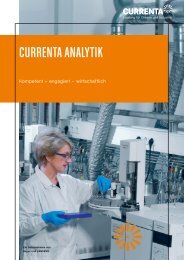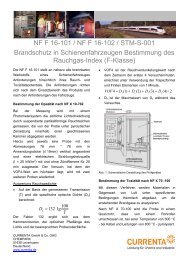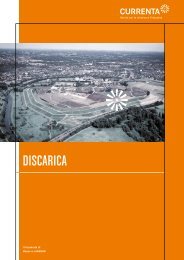Layman report - Currenta
Layman report - Currenta
Layman report - Currenta
Create successful ePaper yourself
Turn your PDF publications into a flip-book with our unique Google optimized e-Paper software.
Disposal,<br />
RECYCLING,<br />
Engineering<br />
Waste<br />
Incineration<br />
Wastewater<br />
Treatment<br />
EU-LIFE-Project Sludge Redox<br />
Biogas from Sludge<br />
<strong>Layman</strong>´s Report<br />
A company of<br />
Bayer and LANXESS
Biogas from sewage sludge<br />
Final <strong>report</strong> on a demonstration project - with financial support from the EU LIFE program<br />
This <strong>report</strong> presents the results of a CURRENTA<br />
project to investigate a combination process to reduce<br />
the volume of sewage sludge from industrial sources<br />
on a pilot scale. A total of 20,000 metric tons per<br />
annum of dewatered surplus activated sludge are<br />
available for the generation of biogas at the<br />
CHEMPARK Leverkusen This is the outcome of a<br />
two-year demonstration project that received financial<br />
support from the European Union within the framework<br />
of the LIFE program.<br />
Sewage sludge is an ongoing subject<br />
Germany produces approximately 2 million metric tons<br />
(solids) of sewage sludge per annum. Around one third<br />
of this is currently used to fertilize areas in agricultural<br />
Wastewater treatment plant in the Leverkusen Waste Management Center<br />
The project “Sludge Redox” presented here is the last<br />
link to date in a long chain of research projects that<br />
have been carried out by Bayer AG, Bayer Industry<br />
Services and CURRENTA for over 20 years. The Porteous<br />
process – a thermal process for treating sewage<br />
sludge with a high organic content – was applied at the<br />
Leverkusen site in the 1980s to improve the dewatering<br />
of the sludge. The sludge was heated to 170 °C in<br />
that process. In the 1990s a process was developed<br />
for the alkaline hydrolysis of sewage sludge. Sludge<br />
digestion, a common process in municipal wastewater<br />
treatment plants, was also tested. Unfortunately, it was<br />
not possible to convert industrial sewage sludge<br />
efficiently into biogas with this method.<br />
use. Sewage sludge from industrial sources – which<br />
often contains residues e. g. heavy metals – is incinerated.<br />
This process is expensive. The search for new<br />
sewage sludge disposal processes that are less<br />
expensive and have a lower environmental impact is<br />
important because of the large quantities of industrial<br />
sewage sludge generated. The EU therefore supports<br />
research activities that are aimed at developing new<br />
processes to reduce the quantity of sewage sludge and<br />
save energy.<br />
Membrane filter press for dewatering sludge at the wastewater treatment plant<br />
Leverkusen<br />
2 <strong>Layman</strong>´s Report
Biogas from sewage sludge<br />
Industrial sewage sludge is a very special<br />
substance<br />
The challenges facing scientists in wastewater treatment<br />
plants of the chemical industry were fundamentally<br />
different to those in the communal sector. Wastewater<br />
from a Chemical Park has high concentrations of<br />
many different chemicals. Frequently it is necessary to<br />
pretreat plant effluents to make it biodegradable.<br />
Numerous chemicals are harmful to anaerobic bacteria<br />
that generate biogas from organic substances in the<br />
absence of air. For decades it proved impossible to<br />
generate biogas from chemical wastewater. But the<br />
wastewater loads have changed considerably in many<br />
Chemical Parks since the end of the 1990s as a result<br />
of new, more efficient manufacturing processes.<br />
Bacteria that could not withstand the wastewater<br />
conditions a few years ago can survive in wastewater<br />
today.<br />
Günter Müller shows the participants of the LIFE symposium lab-scale plant for sludge reduction<br />
Combined treatment process for industrial<br />
sewage sludge<br />
However, despite all of the process improvements the<br />
industrial sewage sludge generated today can still not<br />
be digested that readily. Chemists, biologists, engineers<br />
and technologists of CURRENTA have now<br />
shown how this is possible: The key to the process is<br />
the judicious combination of treatment steps that are<br />
already known. In the first step all water-soluble<br />
substances are removed using large volumes of water.<br />
Sulfate is also removed in this step as this would<br />
otherwise be converted by bacteria to foul-smelling<br />
hydrogen sulfide which is toxic to bacteria. The<br />
washing step is necessary to avoid subsequent<br />
adverse effects on digestion. The sludge floccules<br />
(which form surplus activated sludge) are then<br />
destroyed with sodium hydroxide at temperatures<br />
above 90 °C.<br />
Organic components, especially proteins, lipids and<br />
carbohydrates are very largely converted into watersoluble<br />
substances. By this step the solid concentration<br />
can be reduced significantly. Before anaerobic<br />
treatment neutralization of the hydrolysate is necessary.<br />
The neutralized hydrolysate is treated in an anaerobic<br />
bioreactor at 35 °C. In anaerobic treatment first longchain<br />
carboxylic acids are formed; these are further<br />
converted to short-chain carboxylic acids. In the final<br />
step anaerobic bacteria use this compounds to generate<br />
biogas (approx. 60 % methane and 40 % carbon<br />
dioxide). Biogas can be used for heating, electricity<br />
generation or after purification in compressed natural<br />
gas vehicles.<br />
<strong>Layman</strong>´s Report 3
Biogas from sewage sludge<br />
SLUDGE REDOX Method<br />
Water<br />
Alkaline solution<br />
Biogas<br />
Surplus<br />
activated sludge<br />
Washing<br />
step<br />
Alkaline<br />
hydrolysis<br />
Anaerobic<br />
treatment<br />
Residual<br />
sludge<br />
Watersoluble<br />
components<br />
Alkaline hydrolysis system<br />
Anaerobic treatment system<br />
4 <strong>Layman</strong>´s Report
Biogas from sewage sludge<br />
Activated sludge, untreated<br />
Activated sludge after alkaline hydrolysis<br />
Sludge after anaerobic treatment<br />
The photomicrographs of sewage sludge bacteria<br />
below show that the sludge floccules are very largely<br />
dissolved after hydrolysis with sodium hydroxide. The<br />
subsequent anaerobic treatment converts the remaining<br />
floccules partially into biogas. All that remains are<br />
fragments of the previously numerous sludge<br />
floccules. The remaining sludge will be dewatered and<br />
incinerated. The sulphate containing washing water<br />
and the effluent of the anaerobic bioreactor are treated<br />
in the wastewater treatment plant.<br />
Surplus activated<br />
sludge<br />
Washed surplus<br />
activated sludge<br />
Balance of the solids after<br />
hydrolysis and anaerobic<br />
treatment<br />
Biogas<br />
13 %<br />
100 % 98 % 30 %<br />
Solids in<br />
residual<br />
sludge<br />
2 %<br />
55 %<br />
Solubilised solids to<br />
wastewater treatment plant<br />
Solubilised solids to<br />
wastewater treatment plant<br />
<strong>Layman</strong>´s Report 5
Biogas from sewage sludge<br />
Use of sewage sludge for energy production<br />
At the industrial wastewater treatment plant (wwtp) in<br />
Leverkusen sewage sludge is first thickened before<br />
adding lime and iron salts for conditioning. Afterwards<br />
the sludge is dewatered in a membrane filter press.<br />
the calorific value is low (3,000 to 4,000 kJ/kg).<br />
Therefore it is necessary to add substances with high<br />
calorific value for sludge combustion.<br />
The Sludge Redox process generates biogas with a<br />
calorific value of 22,000 kJ/Nm 3 from. Each day 2,000<br />
to 3,000 Nm 3 biogas can be generated at the wwtp<br />
Leverkusen. More than 50 % of the energy in the<br />
surplus activated sludge can be recovered in the<br />
biogas. In the same way the amount of waste from<br />
surplus activated sludge is reduced by 70 %. The<br />
remaining sludge is reduced in organic substances and<br />
therefore the calorific value is also reduced.<br />
Karl-Heinz Stürznickel shows a component of the pilot plant for sludge reduction.<br />
After this treatment the filter cake still has a water<br />
content of about 60 %. Because of the water content<br />
and high content of inorganic substances in the sludge<br />
LIFE symposion<br />
The results of the LIFE Project “SLUDGE REDOX”<br />
were presented at 17 th September 2007 in the<br />
Leverkusen Waste Management Center. Operators of<br />
industrial and municipal wastewater treatment plants<br />
and scientists from universities and research institutes<br />
participated the symposion.<br />
Presentation of Hartmut Mayer (Emschergenossenschaft, Essen) at the LIFE symposium.<br />
6 <strong>Layman</strong>´s Report
Biogas from sewage sludge<br />
Cost-effectiveness of the combination<br />
process<br />
Although pilot-scale studies were successful, further<br />
studies will be necessary to make the new process<br />
economically viable. The large amount of sodium<br />
hydroxide solution needed to dissolve the sludge<br />
floccules means that the entire process costs €120 –<br />
140 per metric ton of sewage sludge and is therefore<br />
markedly more expensive than conventional sewage<br />
sludge incineration which costs €50 – 100 per metric<br />
ton of sludge. Even if the savings made through the<br />
use of biogas for electricity generation are included in<br />
the calculation, the process still does not reach the<br />
point of being viable economically. Further work should<br />
focus on improving the economic viability of the<br />
process in a larger pilot plant.<br />
The process can be further improved by:<br />
- application of low-cost alkaline waste<br />
- reduction of the energy consumption in<br />
the process<br />
- increase of the biogas output<br />
Sludge digestion in the future<br />
Future work will focus on the utilization of the energy<br />
present in the sewage sludge. The use of sewage<br />
sludges to yield renewable energy is an important step<br />
to improve the energy efficiency of wastewater treatment<br />
plants and to reduce carbon dioxide emissions.<br />
Dr. Fritz Bremer explained the participants of the symposion the control room of the wastewater treatment plant and the process engineering unit at the Waste Management Center.<br />
For further information on the project please<br />
contact: Dr. Guenter Mueller, <strong>Currenta</strong>, Geb. 4242,<br />
51368 Leverkusen , phone +49-214-3066227,<br />
e-mail: guenter.mueller@currenta.de<br />
<strong>Layman</strong>´s Report 7


